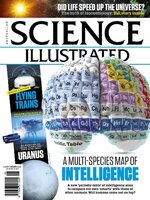Science Illustrated delivers natural science, break through discoveries and an understanding of the world for the entire family. Packed with stunning photography and in-depth editorial it’s a visually spectacular gateway to the world looking into the beginning of life to distant objects in the universe.
SUBSCRIBE TO SCIENCE ILLUSTRATED FOR YOUR CHANCE TO WIN!
Science Illustrated
Taking the Veil: supernova delivers colour explosion
Flower power: raising awareness through art
Mammoth’s mammoth migration over 28 years • Scientists have created a detailed map of a lifetime’s migration for a single woolly mammoth, using 400,000 samples from a tusk to establish that it travelled a total of 80,000km.
The Moon never had a magnetic field • New analyses of lunar rock collected in the 1970s show that the Moon has never had a protective magnetic field. And that is good news for future lunar missions.
Windbreak walls boost efficiency • Obstacles in the landscape in front of wind turbines can increase wind speeds higher up in the air and so improve energy generation by up to 10%.
New ‘green Concorde’ could take off in 2025 • ‘Overture’ is the name of a new supersonic aircraft that could soon take flight. The plane looks like Concorde, but is much less noisy and will be powered by a special type of carbon-neutral fuel.
Spanish Flu recovered from a museum
By a devil’s whisker…
Three turtle tales • Australian scientists report on turtles today, turtles of the past, and turtles you can watch in the future.
The first people in Asia disappeared after 7000 years • According to the latest DNA analyses, Asia was populated twice – thousands of years apart.
Scientists invent the world’s smallest amplifier • A new tiny amplifier is 1000 times thinner than a human hair. But it amplifies tiny sound waves instead of electrons.
Is water vapour more harmful to climate than carbon dioxide? • “I have read that water vapour is a greenhouse gas just like CO2 and that water vapour also causes heating. But which of the two gases is more potent, and which is more climate-friendly?”
TOP 5 · Which islands are the most densely populated? • “I just visited New York and Manhattan Island, where every square kilometre is inhabited by 28,000 people. But which islands are the world’s most densely populated”
Why are the Sun and the Moon not the same colour? • “Why does the Sun often seem yellow, whereas the Moon looks more white? If it is just reflecting the Sun’s light, shouldn’t it appear the same colour?”
How did the Inuit avoid scurvy without fresh fruit? • The Inuit had no direct access to fresh fruit and vegetables, so how did they avoid the scurvy that afflicted sailors?
Does Earth become heavier over time? • “If dust and meteorites continuously strike Earth, does this mean that Earth is becoming heavier all the time?”
Why do we sweat? • We sweat to cool our bodies, which happens as the sweat evaporates. So is it more efficient to leave the sweat in place, on our forehead, for example, or to wipe it away regularly?
Are worn-out wind turbines recycled? • Where do worn-out wind turbines end up, and do they cause a pollution problem?
…you could be swallowed by a whale? • “Recently, an American diver claimed to have been swallowed by a whale, but can whales really swallow people? And could you survive in the stomach of a whale?”
Which animals have been sent into space? • The Soviet space dog Laika was famously the first animal to orbit Earth, but it wasn’t the first creature we sent into space. Which other animals have left Earth – and why?
How destructive are invasive species? • How big are Australia’s problems with non-indigenous species like feral cats and...

 Issue 111
Issue 111
 Issue 110
Issue 110
 Issue 109
Issue 109
 Issue 108
Issue 108
 Issue 107
Issue 107
 Issue 106
Issue 106
 Issue 105
Issue 105
 Issue 104
Issue 104
 Issue 103
Issue 103
 Issue 102
Issue 102
 Issue 101
Issue 101
 Issue 100
Issue 100
 Issue 99
Issue 99
 Issue 98
Issue 98
 Issue 97
Issue 97
 Issue 96
Issue 96
 Issue 95
Issue 95
 Issue 94
Issue 94
 Issue 93
Issue 93
 Issue 92
Issue 92
 Issue 91
Issue 91
 Issue 90
Issue 90
 Issue 89
Issue 89
 Issue 88
Issue 88
